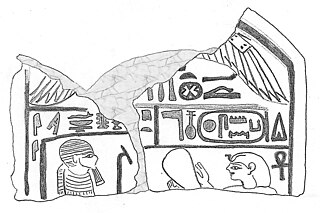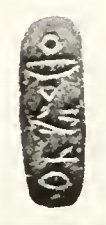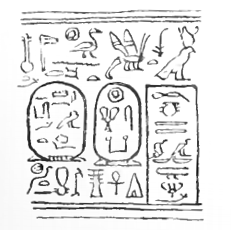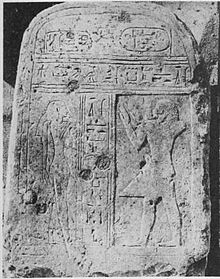
Djedhotepre Dedumose I was an Egyptian pharaoh of the Second Intermediate Period. According to egyptologists Kim Ryholt, Darrell Baker, Aidan Dodson and Dyan Hilton, he was a king of the 16th Dynasty. Alternatively, Jürgen von Beckerath, Thomas Schneider and Detlef Franke see him as a king of the 13th Dynasty.

Sekhemkare Amenemhat V was an Egyptian pharaoh of the early 13th Dynasty during the Second Intermediate Period.

Semenkare Nebnuni is a poorly attested pharaoh of the early 13th Dynasty during the Second Intermediate Period. He is mainly known for his position in the Turin King List.

Nubkheperre Intef was an Egyptian king of the Seventeenth Dynasty of Egypt at Thebes during the Second Intermediate Period, when Egypt was divided by rival dynasties including the Hyksos in Lower Egypt.

Sekhemre Wahkhau Rahotep was an Egyptian pharaoh who reigned during the Second Intermediate Period, when Egypt was ruled by multiple kings. The Egyptologists Kim Ryholt and Darrell Baker believe that Rahotep was the first king of the 17th Dynasty.

Nebmaatre is the prenomen of a poorly attested ruler of the late Second Intermediate Period of Ancient Egypt. Nebmaatre may have been a member of the early 17th Dynasty and as such would have reigned over the Theban region. Alternatively, Jürgen von Beckerath believes that Nebmaatre was a ruler of the late 16th Dynasty.

Sekhemre Sankhtawy Neferhotep III Iykhernofret was the third or fourth ruler of the Theban 16th Dynasty, reigning after Sobekhotep VIII according to Egyptologists Kim Ryholt and Darrell Baker. He is assigned a reign of 1 year in the Turin Canon and is known primarily by a single stela from Thebes. In an older study, Jürgen von Beckerath dated Neferhotep III to the end of the 13th Dynasty.

Sehetepibre Sewesekhtawy was an Egyptian pharaoh of the 13th Dynasty during the early Second Intermediate Period, possibly the fifth or tenth king of the Dynasty.

'Aper-'Anati was a ruler of Lower Egypt during the Second Intermediate Period in the mid-17th century BC. According to Jürgen von Beckerath he was the second king of the 16th Dynasty and a vassal of the Hyksos kings of the 15th Dynasty. This opinion was recently rejected by Kim Ryholt. In his 1997 study of the Second Intermediate Period, Ryholt argues that the kings of the 16th Dynasty ruled an independent Theban realm c. 1650–1580 BC. Consequently, Ryholt sees 'Aper-'Anati as an early Hyksos king of the 15th Dynasty, perhaps its second ruler. This analysis has convinced some Egyptologists, such as Darrell Baker and Janine Bourriau, but not others including Stephen Quirke.

Djedneferre Dedumose II was a native ancient Egyptian pharaoh during the Second Intermediate Period. According to egyptologists Kim Ryholt and Darrell Baker, he was a ruler of the Theban 16th Dynasty. Alternatively, Jürgen von Beckerath, Thomas Schneider and Detlef Franke see him as a king of the 13th Dynasty.
Iufni was an ancient Egyptian pharaoh of the 13th Dynasty during the Second Intermediate Period.

Khahotepre Sobekhotep VI was an Egyptian king of the late 13th Dynasty during the Second Intermediate Period.

Sekhemkare Amenemhat Senebef was an Egyptian pharaoh of the early 13th Dynasty, often considered as the final part of the late Middle Kingdom or early Second Intermediate Period.

The Abydos Dynasty is hypothesized to have been a short-lived local dynasty ruling over parts of Middle and Upper Egypt during the Second Intermediate Period in Ancient Egypt. The Abydos Dynasty would have been contemporaneous with the Fifteenth and Sixteenth Dynasties, from approximately 1650 to 1600 BC. It would have been based in or around Abydos and its royal necropolis might have been located at the foot of the Mountain of Anubis, a hill resembling a pyramid in the Abydene desert, close to a rock-cut tomb built for pharaoh Senusret III.

Sekhemraneferkhau Wepwawetemsaf was an Egyptian pharaoh during the Second Intermediate Period.

Menkhaure Snaaib was an Egyptian pharaoh during the Second Intermediate Period between the Middle Kingdom and New Kingdom at the end of the Middle Bronze Age.

Sekhemrekhutawy Khabaw was an Egyptian pharaoh of the early 13th Dynasty during the Second Intermediate Period.

Sewahenre Senebmiu is a poorly attested Egyptian pharaoh during the Second Intermediate Period, thought to belong to the late 13th Dynasty.
Khuiqer was an ancient Egyptian pharaoh known only for a limestone lintel bearing part of his royal titulary, found in Abydos by Flinders Petrie at the beginning of the 20th century, and now located at the University of Pennsylvania Museum of Archaeology and Anthropology. His datation is extremely uncertain since he was tentatively placed in both the First and the Second Intermediate Period.
Bebnum is a poorly known ruler of Lower Egypt during the Second Intermediate Period, reigning in the early or mid 17th century BC.

















